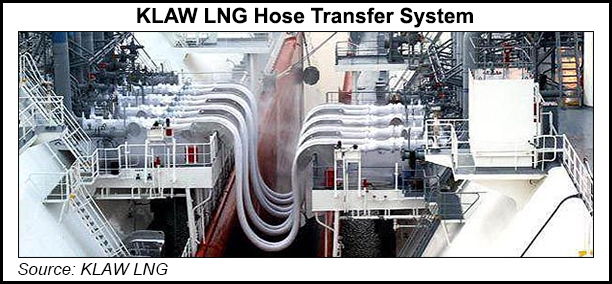NGI The Weekly Gas Market Report | Infrastructure | LNG | NGI All News Access
KLAW, Dutch Shell Expanding LNG Bunkering Opportunities with Hose Transfer System
Signum Technology Group’s KLAW LNG and Royal Dutch Shell plc have engineered and conducted a ship-to-ship hose transfer system (HTS) bunkering operation using the liquefied natural gas (LNG) bunker vessel Cardissa.

The system incorporates a compact level 2 Safety Integrity Level (SIL2) and safety instrumented system, which is said to reduce potential for human errors.
“The question of safety is always the main driver of technology in LNG transfer and ship-to-ship bunkering is innately challenging due to the need to factor in adverse tide and weather conditions and the unpredictable movement of the two vessels,” said Signum’s Jeff Vile, sales and compliance director.
KLAW’s transfer system is operational for ship-to-ship as well as ship-to-shore LNG transfers. The system features a two-stage emergency shutdown system (ESD1, ESD2) that can be activated automatically or manually.
Triggered by crew or by vessel movements, ESD1 shuts down cargo transfer pumps, then isolates transfer lines and sounds a warning alarm. The next stage, ESD2, activates emergency release coupling and separates the transfer system.
“The architecture removes almost all human inputs from the transfer system set up and operation,” Vile said. “This maximizes cost efficient availability and vastly reduces the potential for human error. It also ensures that the components work seamlessly together and can be effectively managed over the system’s entire lifecycle.”
Following its operational installation, the system completed its first ship-to-ship bunkering of LNG fuel to one of Russian shipping company Sovcomflot’s LNG-powered Aframax tankers. This was said to be the first time LNG ship-to-ship bunkering was undertaken in the Port of Rotterdam, as well as the first LNG fuelling of an Aframax tanker.
The International Maritime Organization (IMO) wants to expand the use of LNG in fueling operations to cut sulfur content in ship fuels beginning in 2020. In March, the Energy Information Administration said that over the past several years many ships have either built with, or were offered to be equipped with, LNG-ready engines to meet the IMO’s 2020 standards. Such engines would be configured to run on LNG at a later date.
© 2024 Natural Gas Intelligence. All rights reserved.
ISSN © 1532-1231 | ISSN © 2577-9877 | ISSN © 1532-1266 |
